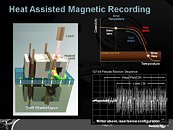Raevenlord
News Editor
- Joined
- Aug 12, 2016
- Messages
- 3,755 (1.18/day)
- Location
- Portugal
| System Name | The Ryzening |
|---|---|
| Processor | AMD Ryzen 9 5900X |
| Motherboard | MSI X570 MAG TOMAHAWK |
| Cooling | Lian Li Galahad 360mm AIO |
| Memory | 32 GB G.Skill Trident Z F4-3733 (4x 8 GB) |
| Video Card(s) | Gigabyte RTX 3070 Ti |
| Storage | Boot: Transcend MTE220S 2TB, Kintson A2000 1TB, Seagate Firewolf Pro 14 TB |
| Display(s) | Acer Nitro VG270UP (1440p 144 Hz IPS) |
| Case | Lian Li O11DX Dynamic White |
| Audio Device(s) | iFi Audio Zen DAC |
| Power Supply | Seasonic Focus+ 750 W |
| Mouse | Cooler Master Masterkeys Lite L |
| Keyboard | Cooler Master Masterkeys Lite L |
| Software | Windows 10 x64 |
Seagate has been hyping their new HDD density-improvement technology, HAMR, for some time now. The basis of HAMR (Heat-Assisted Magnetic Recording) in Seagate's ypcoiming HDDs is to increase platter density without having to resort to other solutions so as to increase HDD capacity (increased number of platters, increased footprint, etc). The company says that internal tests of 16 TB HAMR-based HDDs are going well, with expected market release to partners by 2019.
HAMR does keep up with compatibility for enterprise customers, being a drop-in upgrade for other HDD-based storage solutions - they're just higher capacity, higher-performance solutions that don't need any special treatment from deployers. The plan is to release 20 TB solutions by 2020, and a staggering 48 TB in the standard 3.5" form-factor by 2024. Seagate further states that HAMR-based drives far exceed industry-required reliability parameters, so the company is bullish on the attention its technology will garner once available to customers in general. The HAMR tech will be deployed firstly on the company's



"Seagate has begun running early Exos HAMR units through the full set of standard benchmark tests used to prepare and optimize each new hard drive product for deployment," says Jason Feist, Seagate's senior director of enterprise product line management. "Our testing has demonstrated the drives' compatibility for enterprise systems that are being used today. No system level changes are needed to run the HAMR drives in these evaluations, or to deploy them in customer environments."
View at TechPowerUp Main Site
HAMR does keep up with compatibility for enterprise customers, being a drop-in upgrade for other HDD-based storage solutions - they're just higher capacity, higher-performance solutions that don't need any special treatment from deployers. The plan is to release 20 TB solutions by 2020, and a staggering 48 TB in the standard 3.5" form-factor by 2024. Seagate further states that HAMR-based drives far exceed industry-required reliability parameters, so the company is bullish on the attention its technology will garner once available to customers in general. The HAMR tech will be deployed firstly on the company's



"Seagate has begun running early Exos HAMR units through the full set of standard benchmark tests used to prepare and optimize each new hard drive product for deployment," says Jason Feist, Seagate's senior director of enterprise product line management. "Our testing has demonstrated the drives' compatibility for enterprise systems that are being used today. No system level changes are needed to run the HAMR drives in these evaluations, or to deploy them in customer environments."
View at TechPowerUp Main Site







